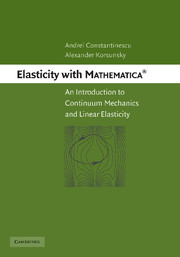Book contents
- Frontmatter
- Contents
- Acknowledgments
- Introduction
- 1 Kinematics: displacements and strains
- 2 Dynamics and statics: stresses and equilibrium
- 3 Linear elasticity
- 4 General principles in problems of elasticity
- 5 Stress functions
- 6 Displacement potentials
- 7 Energy principles and variational formulations
- Appendix 1 Differential operators
- Appendix 2 MATHEMATICA® tricks
- Appendix 3 Plotting parametric meshes
- Bibliography
- Index
5 - Stress functions
Published online by Cambridge University Press: 11 November 2009
- Frontmatter
- Contents
- Acknowledgments
- Introduction
- 1 Kinematics: displacements and strains
- 2 Dynamics and statics: stresses and equilibrium
- 3 Linear elasticity
- 4 General principles in problems of elasticity
- 5 Stress functions
- 6 Displacement potentials
- 7 Energy principles and variational formulations
- Appendix 1 Differential operators
- Appendix 2 MATHEMATICA® tricks
- Appendix 3 Plotting parametric meshes
- Bibliography
- Index
Summary
OUTLINE
This chapter is devoted to the solution of elastic problems using the stress function approach. The Beltrami potential has already been introduced previously as a convenient form of representation for self-equilibrated stress fields. However, the main emphasis in the chapter is placed on the analysis of the Airy stress function formulation, even though it represents only a particular case of the Beltrami representation. The reason for this is the particular importance of this approach in the context of plane elasticity.
The Airy stress function approach is introduced taking particular care to ensure that conditions of strain compatibility are properly satisfied. The approximate nature of the plane stress formulation is elucidated.
The properties of Airy stress functions in cylindrical polar coordinates are then addressed. Particular care is taken to analyse some important fundamental solutions that serve as nuclei of strain within the elasticity theory, namely the solutions for a disclination, dislocations and dislocation dipoles, and concentrated forces.
Williams eigenfunction analysis of the stress state in an elastic wedge under homogeneous loading is presented next, and the elastic stress fields found around the tip of a sharp crack subjected either to opening or shear mode loading. Finally, two further important problems are treated, namely the Kirsch problem of remote loading of a circular hole in an infinite plate, and the Inglis problem of remote loading of an elliptical hole in an infinite plate.
- Type
- Chapter
- Information
- Elasticity with Mathematica ®An Introduction to Continuum Mechanics and Linear Elasticity, pp. 116 - 156Publisher: Cambridge University PressPrint publication year: 2007



